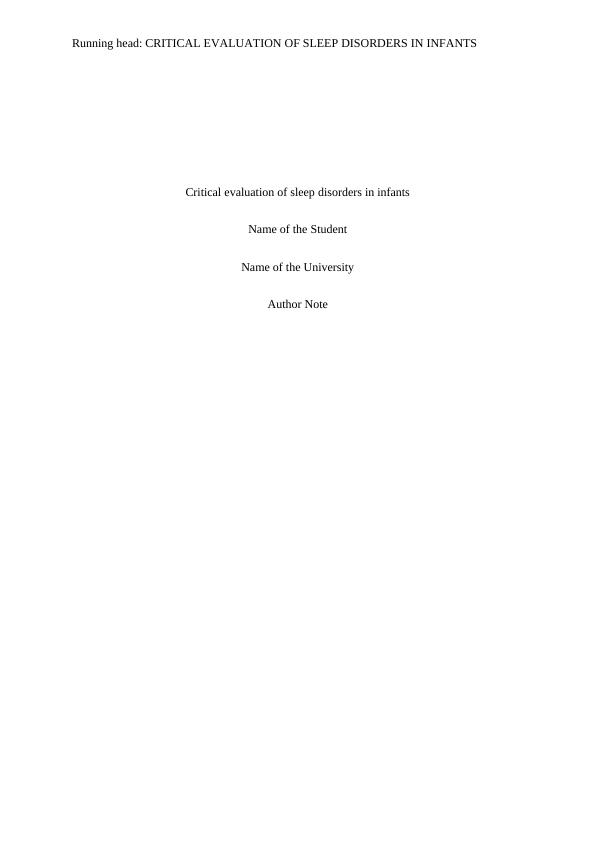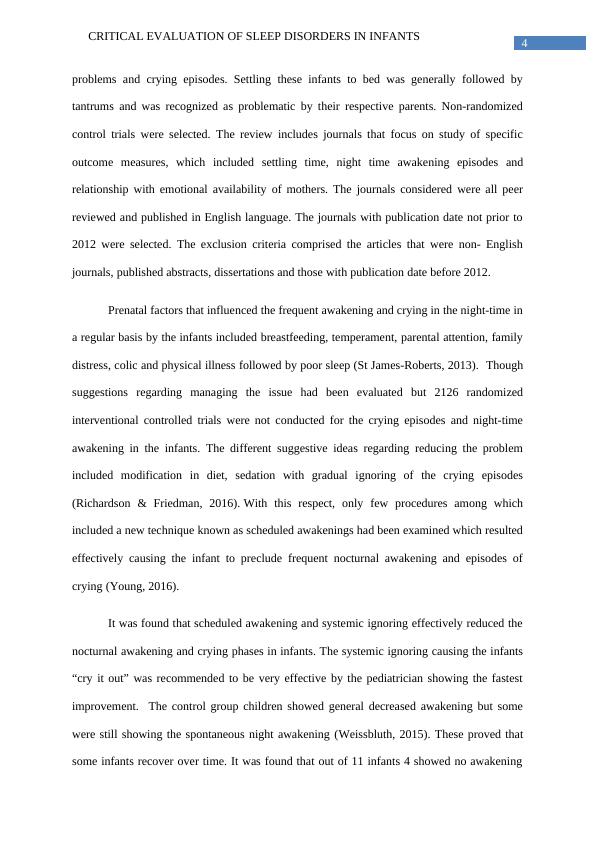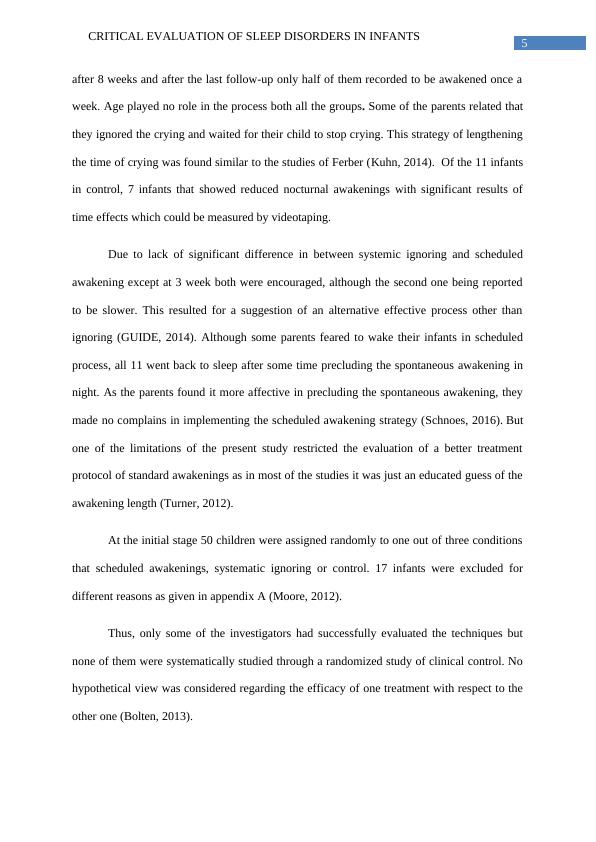Ask a question from expert
Sleep Disorders in Infants Critical Evaluation Report
23 Pages4546 Words229 Views
Added on 2020-04-07
Sleep Disorders in Infants Critical Evaluation Report
Added on 2020-04-07
BookmarkShareRelated Documents
Running head: CRITICAL EVALUATION OF SLEEP DISORDERS IN INFANTSCritical evaluation of sleep disorders in infants Name of the StudentName of the UniversityAuthor Note

1CRITICAL EVALUATION OF SLEEP DISORDERS IN INFANTSExecutive SummaryThe infants showing spontaneous awakening and crying phases in the night time wererandomly included in three groups dividing equally such as scheduled awakenings,systematic ignoring or control. Scheduled awakenings procedure had parent arousing andconsoling or feeding the infant 15-60 minutes prior to spontaneous awakenings. Onceprecluded, parents with scheduled awakenings were systematically eliminated. Systematicignoring comprised of letting the infant to “cry it out” lacking parental attention except attimes to ensure the safety of the infant. Infants included in the groups of scheduledawakening and systematic ignoring was found to awoke and cry less than compared with theinfants in the controlled group in the treatment duration of 8 weeks and follow-ups aftertreatment for 3 and 6 weeks. Systematic ignoring was recorded to show more effective resultsthan scheduled awakenings in the first week of treatment or else the efficacy of both thetreatments were found to be same. The different implications of the treatment processes werealso discussed.

2CRITICAL EVALUATION OF SLEEP DISORDERS IN INFANTSTable of ContentsIntroduction................................................................................................................................3Literature review........................................................................................................................3Search protocol.......................................................................................................................3Inclusion and exclusion criteria.............................................................................................3Critically appraisal tool..............................................................................................................6CASP tool for control trials....................................................................................................6Results......................................................................................................................................15Conclusion................................................................................................................................15References................................................................................................................................17Appendix A..............................................................................................................................20Appendix B..............................................................................................................................21Appendix C..............................................................................................................................22Appendix D..............................................................................................................................23Appendix E...............................................................................................................................24

3CRITICAL EVALUATION OF SLEEP DISORDERS IN INFANTSIntroductionOne of the common and significant issues faced by the parents are the not sleepingbehaviour throughout the night and thereby restricting from going to sleep by their children(Sivertsen et al., 2015). The persistence of the sleep disruptions with crying episodes led tonegative impacts on the parents such as distress, fatigue and decrease in the tolerance towardsthe night time problems (O’Neill & Gilea, 2017). The other part of concern was that some ofthe parents who faced the issues regarding episodes of crying in night by infants did notconsult any professionals to solve the problem (Bell, 2014).The difficulties faced in thebedtime sleep led to child abuse, maternal ambivalence and maternal depression towards theirchild (Weinraub et al., 2012). Keeping this issue into consideration, professional supportplayed major role in solving the spontaneous awakening and crying phases in night furtherpreventing the conflict of parent-child (Mindell & Owens, 2015).Literature reviewSearch protocolIn this review, different databases were considered such as MEDLINE, SCOPUS,EMBASE, CINAHL and Cochrane Library. The search terms were “child,” “toddler,”“infant,” “sleep,” “settling,” “wake,” “treatment,” “medication,” “therapy,” and“intervention”. The searching pattern was supplemented through tracking all the articles andcited reviews, bibliography, books as well as hand searching the journals based on the topicfor the last 5 years. Inclusion and exclusion criteriaThe studies that were included in this review were centred within young children aged5 or younger, who represented nocturnal awakening at night time, with established sleep

4CRITICAL EVALUATION OF SLEEP DISORDERS IN INFANTSproblems and crying episodes. Settling these infants to bed was generally followed bytantrums and was recognized as problematic by their respective parents. Non-randomizedcontrol trials were selected. The review includes journals that focus on study of specificoutcome measures, which included settling time, night time awakening episodes andrelationship with emotional availability of mothers. The journals considered were all peerreviewed and published in English language. The journals with publication date not prior to2012 were selected. The exclusion criteria comprised the articles that were non- Englishjournals, published abstracts, dissertations and those with publication date before 2012.Prenatal factors that influenced the frequent awakening and crying in the night-time ina regular basis by the infants included breastfeeding, temperament, parental attention, familydistress, colic and physical illness followed by poor sleep (St James-Roberts, 2013). Thoughsuggestions regarding managing the issue had been evaluated but 2126 randomizedinterventional controlled trials were not conducted for the crying episodes and night-timeawakening in the infants. The different suggestive ideas regarding reducing the problemincluded modification in diet, sedation with gradual ignoring of the crying episodes(Richardson & Friedman, 2016).With this respect, only few procedures among whichincluded a new technique known as scheduled awakenings had been examined which resultedeffectively causing the infant to preclude frequent nocturnal awakening and episodes ofcrying (Young, 2016).It was found that scheduled awakening and systemic ignoring effectively reduced thenocturnal awakening and crying phases in infants. The systemic ignoring causing the infants“cry it out” was recommended to be very effective by the pediatrician showing the fastestimprovement. The control group children showed general decreased awakening but somewere still showing the spontaneous night awakening (Weissbluth, 2015). These proved thatsome infants recover over time. It was found that out of 11 infants 4 showed no awakening

5CRITICAL EVALUATION OF SLEEP DISORDERS IN INFANTSafter 8 weeks and after the last follow-up only half of them recorded to be awakened once aweek. Age played no role in the process both all the groups. Some of the parents related thatthey ignored the crying and waited for their child to stop crying. This strategy of lengtheningthe time of crying was found similar to the studies of Ferber (Kuhn, 2014). Of the 11 infantsin control, 7 infants that showed reduced nocturnal awakenings with significant results oftime effects which could be measured by videotaping. Due to lack of significant difference in between systemic ignoring and scheduledawakening except at 3 week both were encouraged, although the second one being reportedto be slower. This resulted for a suggestion of an alternative effective process other thanignoring (GUIDE, 2014). Although some parents feared to wake their infants in scheduledprocess, all 11 went back to sleep after some time precluding the spontaneous awakening innight. As the parents found it more affective in precluding the spontaneous awakening, theymade no complains in implementing the scheduled awakening strategy (Schnoes, 2016).Butone of the limitations of the present study restricted the evaluation of a better treatmentprotocol of standard awakenings as in most of the studies it was just an educated guess of theawakening length (Turner, 2012).At the initial stage 50 children were assigned randomly to one out of three conditionsthat scheduled awakenings, systematic ignoring or control. 17 infants were excluded fordifferent reasons as given in appendix A (Moore, 2012).Thus, only some of the investigators had successfully evaluated the techniques butnone of them were systematically studied through a randomized study of clinical control. Nohypothetical view was considered regarding the efficacy of one treatment with respect to theother one (Bolten, 2013).

End of preview
Want to access all the pages? Upload your documents or become a member.
Related Documents
Research Literacy for Health Practice Assignmentlg...
|17
|3750
|38
HSH725 - Report on Personal Health Practicelg...
|15
|3586
|220
Critical Analysis using CASP Tool Reportlg...
|16
|3782
|330